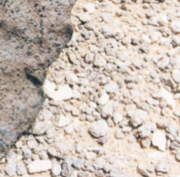Official Name:
476
th meteorite recorded in the Dar al Gani area. It is often called "DaG 476" for short.
Location:
The Dar al Gani plateau is a vast territory of 120 by 60 kilometres in the western part of Libya. The Dar al Gani plateau is part of the Sahara Desert.
Fall or Find:
DaG 476 is a find. This meteorite was greatly altered by Earth's climate. It was partially contaminated by some of Earth's light elements during its long stay at the surface of our planet.

Enlargement
Photo of Dar al Gani 476 where it was discovered. The shiny appearance is due to the long time spent in the desert. |
|
Date:
1 May 1998
Mass Recovered:
2 015 grams
Number of Fragments:
Dar al Gani 476 was compared to the meteorite Dar al Gani 489, which was found a few months later in the same area. No significant difference was noted in their composition. They are very likely meteorites from the same fall. It is possible that DaG 476 is related to half a dozen other fragments found in the same area of the desert. If so, this was a multiple fall.
Strewn field:
Dar al Gani 476 and the other meteorites that may be related to the same fall were found between the towns of Zillah, Sabha and Tmassah. This area would correspond to the strewn field.
Circumstances:
Neither the fall nor the events surrounding the discovery of the fragment are known. Most of the original fragment is still the property of its anonymous discoverer.
Type:
Stony meteorite
Class:
Achondrite
Group:
Basaltic shergottite (SNC). DaG 476 is a martian meteorite that formed from volcanic lava.

Enlargement
Photomicrograph of DaG 476 showing a fragment of olivine in a basalt matrix. |
|
|
Composition:
This meteorite has no fusion crust. A cut of Dar al Gani 476 reveals olivine crystals in a fine matrix of pyroxene and feldspar. Olivine is the prevalent substance, accounting for 60% of the stone's volume. Of the Martian achondrites from the shergottite group, Dar al Gani 476 is the one that contains the most magnetite. The meteorite shows signs of the impact that ejected it from the planet Mars.
Scientific contribution:
This meteorite remained in space for about 1.1 billion years, which is typical for the Martian meteorites.
The concentration of certain isotopes reveals that this meteorite was in the Sahara Desert for 60 000 years. Analysis of DaG 476 has made it possible to better evaluate and understand alterations associated with the terrestrial climate.
Comments:
Dar al Gani 476 was discovered fairly recently and was the thirteenth Martian meteorite to be identified. Since then, the list of meteorites that come from our neighbouring planet has grown.
Part of the Planétarium's collection:
Yes